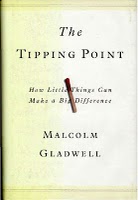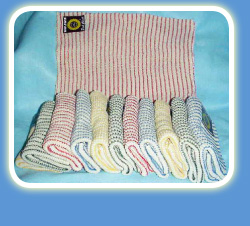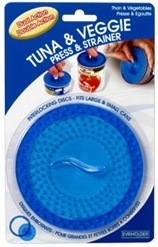The Tipping Point by Malcolm Gladwell
 After reading Made to Stick, I decided to read the book that inspired it—The Tipping Point: How Little Things Can Make a Big Difference by Malcolm Gladwell. I’d read Blink and Outliers by the same author and found both fascinating. I’m happy to report The Tipping Point is just as good. In it, Gladwell examines what conditions cause ideas, behaviors, messages, and products to spread like outbreaks of infectious disease.
After reading Made to Stick, I decided to read the book that inspired it—The Tipping Point: How Little Things Can Make a Big Difference by Malcolm Gladwell. I’d read Blink and Outliers by the same author and found both fascinating. I’m happy to report The Tipping Point is just as good. In it, Gladwell examines what conditions cause ideas, behaviors, messages, and products to spread like outbreaks of infectious disease.
In the book he shares a number of situations and studies, including the sudden drop in crime in New York city in the 1990’s (which started by attacking graffiti in the subway), the dramatic popularity of the Blue’s Clues TV program with pre-schoolers, Paul Revere’s success in rousing the citizens along his route (versus the almost total failure of the other guy who rode that night), the resurgence of Hush Puppies shoes, syphilis in Baltimore, Columbia Record’s amazingly effective golden box ad campaign, and a dozen other outbreaks. From all of these, he extrapolates three rules of social epidemics—The Law of the Few, The Stickiness Factor, and The Power of Context.
 The arguments Gladwell presents are thought-provoking and powerful, but what makes him such a treat to read is how he writes. Like the best science writers (in fact, I think he IS one of the best), he tells great stories with interesting characters. He puts the reader on the edge of the seat with mystery, insight, and humor. He makes things that could be incredibly complex seem like first grade math. It’s as if he’s standing right there with you chatting about the subject. Moreover, he does all this from page one.
The arguments Gladwell presents are thought-provoking and powerful, but what makes him such a treat to read is how he writes. Like the best science writers (in fact, I think he IS one of the best), he tells great stories with interesting characters. He puts the reader on the edge of the seat with mystery, insight, and humor. He makes things that could be incredibly complex seem like first grade math. It’s as if he’s standing right there with you chatting about the subject. Moreover, he does all this from page one.
Here’s what I mean. I left the book out on the kitchen table one night after reading a few chapters. The next morning Super Wife came down to quickly eat breakfast and get herself to a meeting. She made the mistake of opening the book to glance at the first page. Twenty-five minutes later she came up for air and realized she was going to be late and dashed out the door. The writing is pure mind control. And I loved every minute of it.
If you’re at all interested in advertising or how fads and movements start, if you want to affect the behavior of customers or local teens, if you just like to read how things work, I think you’ll love this book.
Sunflower Dish Cloths
 I used to suffer along with subpar dish cloths. There were the dish cloths with mesh on one side that were so small you had to rinse them after every wiping stroke. There were the hand cloths made of terri that belonged in a bathroom but were repurposed and were far too big. Then were the cloths that had some slippery crap in the thread that refused to soak up water. And there were the crocheted things that I think we should have put out of their misery when we first got them. Folks suggested we go to sponges. So we did sponges and had similar results.
I used to suffer along with subpar dish cloths. There were the dish cloths with mesh on one side that were so small you had to rinse them after every wiping stroke. There were the hand cloths made of terri that belonged in a bathroom but were repurposed and were far too big. Then were the cloths that had some slippery crap in the thread that refused to soak up water. And there were the crocheted things that I think we should have put out of their misery when we first got them. Folks suggested we go to sponges. So we did sponges and had similar results.
Oh, woe, woe, woe.
Then a kind and loving friend gave us a set of mystery cloths that were incredible. They were large enough that we didn’t need to rinse with every wipe. They had this fantastic weave that was open, yet absorbent, and dried quickly. And the weave had enough of a texture that you could use it to scrub. We received those back in 1999. They lasted us for years and gave us much kitchen cleaning joy. But, alas, like all of mortality, those brave cloths finally began to give up the ghost.
My problem was that I didn’t know who had made those cloths and where I could get more. We looked all over and couldn’t find them. And then, at this year’s Garden City Raspberry Days craft fair, we saw them nestled amidst all the kitsch! We bought as many as we could afford, and went our way rejoicing, fully expecting these to last us until we have grandchildren. Maybe we’ll pass them down as priceless heirlooms. Maybe some day they’ll be featured on Antique Roadshow. Maybe they’ll be resurrected with us and become the official dish cloth of the Millennium when the world is renewed (it could happen).
If you’re sick and tired of sponges and crappy dish cloths, let me suggest you pick up some Sunflower Dish Cloths made by Sangamon Mill. You can order them in bulk at http://www.sangamonmill.com/ , or in smaller quantities online from places like Amazon.
Everiholder’s Veggie & Tuna Press & Strainer
 Do you eat tuna? If so, you know the biggest pain is draining the can. But you don’t have to suffer along any longer using the lid, which doesn’t do a good job at all anyway. There’s a better solution, which Super Wife discovered. It’s called the Tuna and Veggies Press and Strainer by Evriholder: http://www.evriholder.com/Tuna-Veggie-Press.asp. With this little blue piece of higher technology you easily and quickly press all the juices away, and nothing slips out the sides. We love our. You can order it online, although Super Wife found it at our local evil empire Wal-Mart store.
Do you eat tuna? If so, you know the biggest pain is draining the can. But you don’t have to suffer along any longer using the lid, which doesn’t do a good job at all anyway. There’s a better solution, which Super Wife discovered. It’s called the Tuna and Veggies Press and Strainer by Evriholder: http://www.evriholder.com/Tuna-Veggie-Press.asp. With this little blue piece of higher technology you easily and quickly press all the juices away, and nothing slips out the sides. We love our. You can order it online, although Super Wife found it at our local evil empire Wal-Mart store.
That’s it for now. In the next review, I’m going to reveal two killer recipes over which all who partake will salivate and drool—Chocolate Éclair Cake and Dill Potato Salad.














